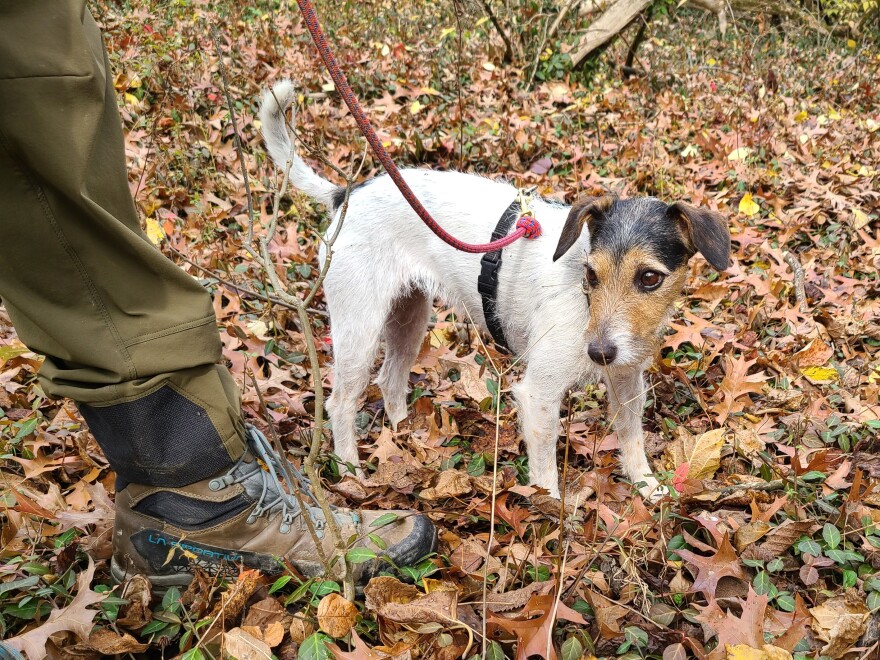As many as 20,000 people are buried in an overgrown cemetery in West Price Hill known as Potter’s Field. The first steps to developing a management plan for the area began Wednesday, with ground-penetrating radar, magnetometers, electromagnetic conductivity surveys... and a pint-sized human remains detection dog named Master Pickpocket, aka Pocket.
The nonprofit Price Hill Will is working with Cincinnati Parks and other groups to map the former cemetery site straddling Guerly Road — half of it is now part of Rapid Run Park; the other half a hillside covered in overgrown honeysuckle and brambles. The findings are part of a restoration process and community-driven effort to create a long-term management plan for the property that also honors those buried there.
Rapid Run Park's roots as a cemetery
"This is a cemetery where roughly 20,000 people are buried, and we don't even know the rudimentaries of where people are buried," explains Michael D. Morgan, president of Queen City History, which is managing the project.
From 1852 to 1981, the cemetery was utilized as a final burying place for those who could not afford burial elsewhere or were unknown at the time of their death. In the past, it was common to reuse a grave site as many as three times, according to the city, with human remains placed closer to the surface with each burial.
There are scant records and few headstones to identify those who are buried here.
"The cemetery was originally 26 acres," Morgan explains. "In 1933, the city transferred roughly half of it to Parks and just started calling it (a) park. We highly suspect that that is actually the oldest part of the cemetery, and a big part of what we recognize as Rapid Run Park — and use as (a) park with playgrounds and grills, etc. — that that's actually a cemetery."
The National Park Service recently awarded Price Hill Will a $34,694 grant for an archaeological survey of the site. Lawrenceburg, Ind.-based group Archaeological Research Institute, Inc. is conducting the work. On Wednesday, they began combing the area with ground-sensing tools to begin identifying burial locations and human remains. They're searching both the Rapid Run Park side and the unmaintained hillside across Guerly Road.
"Those devices are going over that land and they're looking for graves — what they're looking for is actually the indication of where graves had been dug as opposed to bones themselves," Morgan clarifies. "They use three different instruments that work differently to counterbalance and check each other. Then when they're done running those instruments, we're going to run Pocket, the cadaver-sniffing dog that we are here with, over those sites as well."
The survey findings will be compiled into a report that is expected to be completed by the end of the year.
This is a noninvasive survey meant to determine possible and probable burial patterns and the cemetery's historical boundaries. The information is considered the first step in creating a plan for its future — one that the city says "protects, honors and respects all those buried."

Master Pickpocket
Pocket is a 9-year-old Parson Russell Terrier. Her handler, Jennifer Jordan Hall, is the founder of KYK9, a nonprofit providing professional search dog services. Pocket may look small, but Hall says she has a big talent for sniffing out missing people, human remains and forensic crime scene evidence. Not only has she found missing children and adults, Hall reports Pocket has found 1,000-year-old Native American remains.
When Hall gives the command, Pocket drops her nose to the ground and starts moving, sniffing along the ground as she moves at a fast clip down the hillside, weaving under honeysuckle and other underbrush. Hall hustles to keep up as she monitors Pocket's movements for signs she onto something.
The team from the Archaeological Research Institute follow, too, marking locations Hall points out as drawing Pocket's attention. They're logged using GPS to be marked down in the report.
"I love working with these dogs," Hall says. "She's saved some people's lives. She's ... helped solve some crimes. And she's ... I'm just really blessed to be able to be her partner."



